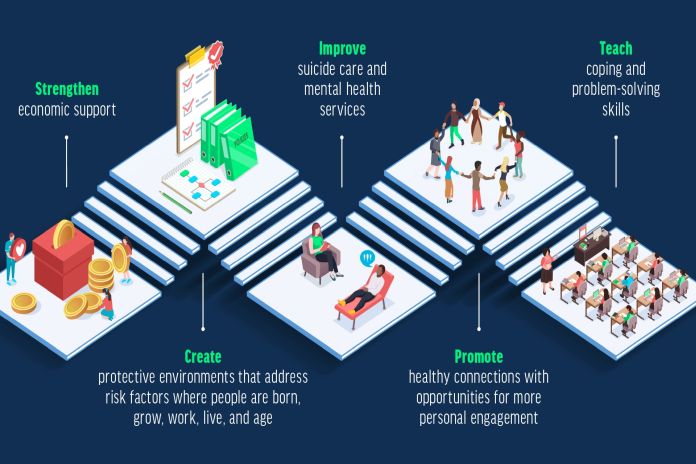ATLANTA, USA – A new CDC Vital Signs report released Monday highlights the role that conditions in counties, such as insurance coverage, broadband internet access, and household income, can play in lowering suicide risk. Compared to counties with the lowest levels of these factors, suicide rates were:
- 26 percent lower in counties with the highest health insurance coverage;
- 44 percent lower in counties where most homes have broadband internet access;
- 13 percent lower in counties with the most household income.
These findings reinforce other studies that show that the conditions where people are born, grow, live, work, and age can play an important role in shaping suicide prevention efforts.
Suicide rates have increased during the last 20 years and remain high. Tragically, more than 49,000 people died by suicide in 2022, and provisional data indicate a similar number of people died by suicide in 2023.
Suicide is the second leading cause of death for people ages 10-34, and other groups continue to have high rates: American Indian or Alaska Native (AI/AN) persons (27.1 per 100,000), males (23.0 per 100,000), rural residents (20.0 per 100,000), and people aged 45-64 (19 per 100,000).
“Every suicide death is tragic, leaving behind devastated families, friends and communities,” said Dr Debra Houry, CDC’s chief medical officer. “Every day, CDC invests in research and data that help reduce the risk of suicide. What we learn, we put into action by designing programs that can save lives and reduce suffering. Today’s report adds to our ever-growing knowledge base of suicide risk factors and will contribute to how we shape future suicide prevention efforts. My hope is that our scientific work and programs to prevent suicides will lead to fewer loved ones being left behind.”
This latest Vital Signs also explores the association of these three factors with suicide rates overall, and what these relationships look like in groups most affected by suicide – all to help inform suicide prevention programs in communities across the country.
Counties with higher levels of health insurance coverage, broadband internet access, and income have lower suicide rates Suicide rates per 100,000 people Health insurance coverage Low: 16 Medium: 14 High:13 Broadband internet access Low: 19 Medium…
Preventing suicide requires multiple interventions. This Vital Signs report stresses the importance of a comprehensive approach to prevent suicide in the first place, and support people at increased risk. Improving conditions in communities can include strengthening household financial security so people can afford food, housing, and medical expenses; fostering healthy connections through community engagement that build social networks; and increasing healthcare provider availability and rapid and remote access to telehealth, mental health services, and crisis intervention, especially in underserved areas.
“Improving the conditions where people are born, grow, live, work, and age is an often overlooked aspect of suicide prevention. Public health programs that improve conditions in communities, such as those funded by CDC’s Comprehensive Suicide Prevention Program, can help people avoid reaching a crisis point,” said Alison Cammack, Ph.D., M.P.H., CDC health scientist and lead author of the report.
CDC continues to take action to prevent suicide by:
- Providing data systems, scientific and technical expertise, strong collaboration, and funding to state health departments, tribes and tribal organizations, territories, academic institutions, and other local coalitions and organizations to help prevent suicide.
- Funding 28 programs around the country to carry out comprehensive suicide prevention programs using proven strategies from CDC’s Suicide Prevention Resource for Action. These strategies are focused on populations most affected by suicide.
- Supporting rapid response in communities to investigate unexpected increases in suicides in a particular location and/or over a certain time frame. These events, known as suicide clusters, often require emergency assistance from CDC experts rapidly deployed to states, tribes, and communities.
Everyone can help prevent suicide by learning the warning signs, promoting prevention and resilience, and committing to social change. Watch for the signs of increased suicide risk, such as isolation, loss, mental illness, and substance use. Act with these five steps to help save the life of someone who may be suicidal: Ask, Be There, Keep Them Safe, Help Them Connect, and Follow Up. Share resources from CDC and the 988 Suicide and Crisis Lifeline public participation site.
Read more about what can be done to reduce suicide in the recent National Strategy for Suicide Prevention and accompanying Federal Action Plan.





